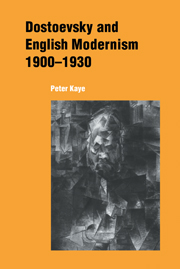Book contents
- Frontmatter
- Contents
- Acknowledgments
- 1 Introduction
- 2 Prophetic rage and rivalry: D. H. Lawrence
- 3 A modernist ambivalence: Virginia Woolf
- 4 Sympathy, truth, and artlessness: Arnold Bennett
- 5 Keeping the monster at bay: Joseph Conrad
- 6 Dostoevsky and the gentleman–writers: E. M. Forster, John Galsworthy, and Henry James
- Conclusion
- Notes
- Selected bibliography
- Index
Conclusion
Published online by Cambridge University Press: 22 September 2009
- Frontmatter
- Contents
- Acknowledgments
- 1 Introduction
- 2 Prophetic rage and rivalry: D. H. Lawrence
- 3 A modernist ambivalence: Virginia Woolf
- 4 Sympathy, truth, and artlessness: Arnold Bennett
- 5 Keeping the monster at bay: Joseph Conrad
- 6 Dostoevsky and the gentleman–writers: E. M. Forster, John Galsworthy, and Henry James
- Conclusion
- Notes
- Selected bibliography
- Index
Summary
As we have seen, Dostoevsky proved to be a lively and disputatious guest in the English house of fiction. Prophet, sage, sadist, monster – none of the writers were quite certain how to name him. He didn't seem a novelist in the usual sense, yet the power of his works could not be blunted, even by his enemies. People speculated about Dostoevsky's lineage, to the point of finding demonic or angelic origins, as if he were a literary foundling badly in need of an explanation. Few bothered to look in the most obvious places for his literary pedigree; Hugo, Balzac, Dickens and other practitioners seemed too far removed from one so exotically Russian.
Perhaps Forster's designation of prophet best encapsulates the English response to Dostoevsky. The prophetic novelist, by Forster's standard, lived beyond the boundaries of rationality. Writers such as Brontë, Melville, Dostoevsky, and Lawrence put aside the usual tools of literary creation to communicate a mystic insight. The “novel through which bardic influence has passed,” Forster drolly points out, “often has a wrecked air, like a drawing room after an earthquake or a children's party.” Forster and his novelist-compatriots all detected a “wrecked air” in Dostoevsky's works. Like Heathcliff at Thrushcross Grange or Queequeg at the Spouter-Inn, the Russian writer bore the marks of an alien; his works were generally regarded as the spume of a tortured soul, not consciously created artifacts of the literary imagination.
- Type
- Chapter
- Information
- Dostoevsky and English Modernism 1900–1930 , pp. 191 - 194Publisher: Cambridge University PressPrint publication year: 1999



